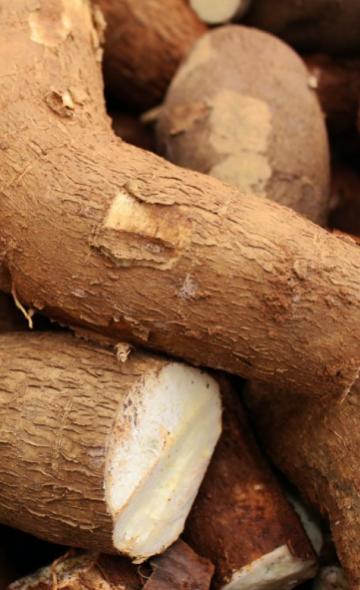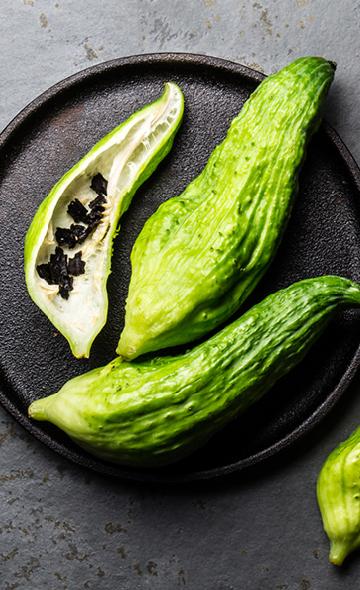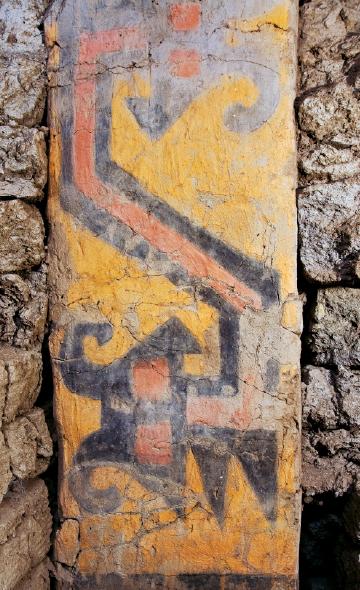- Visitors
- Researchers
- Students
- Community
- Information for the tourist
- Hours and fees
- How to get?
- Visitor Regulations
- Virtual tours
- Classic route
- Mystical route
- Specialized route
- Site museum
- Know the town
- Cultural Spaces
- Cao Museum
- Huaca Cao Viejo
- Huaca Prieta
- Huaca Cortada
- Ceremonial Well
- Walls
- Play at home
- Puzzle
- Trivia
- Memorize
- Crosswords
- Alphabet soup
- Crafts
- Pac-Man Moche
- Workshops and Inventory
- Micro-workshops
- Collections inventory
- News
- Students
- Andean Food Series: Yuca
News
CategoriesSelect the category you want to see:
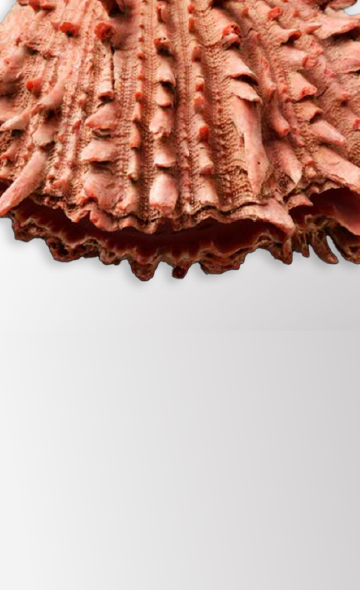
The Use of Spondylus Shells in Moche Ceremonial Contexts: Why Were They Symbols of Status and Wealth? ...
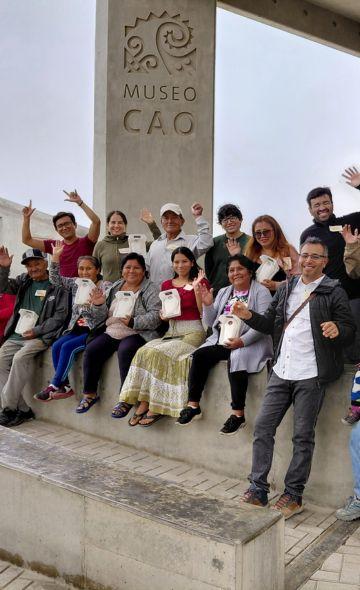
El Brujo Celebrated International Museum Day with Its Community: A Day of Encounter and Cultural Co-Creation ...
To receive new news.
Por: Jose Ismael Alva Ch.
By Jose Ismael Alva Ch. - Resident Archaeologist of the El Brujo Archaeological Complex | Wiese Foundation
Yuca or cassava ("Manihot esculenta") is a tuber native to the American continent and appreciated worldwide as food and, recently, by the biofuel, biochemical and bioplastic industries due to its important starch reserves. Current figures indicate that Africa concentrates 62% of global yuca production, followed by Asia (29%) and the United States (9%) (Canales and Trujillo 2021:5). Let's review together the history of yuca, its consumption as food, as well as its nutritional properties.
The yuca: Domestication and consumption in the Andes
The yuca plant is a shrub that is between 2 and 3 meters tall, able to adapt to less fertile soils and diverse climates (León 2013:100). Two varieties of yuca can be distinguished: bitter yuca, common in the Amazon area, and sweet yuca, frequent among the present territories of Peru and Mexico (Fernández and Rodríguez 2007:137; Leon 2013:98). Specialists have not agreed on the specific area of its origin and domestication, but most point out that the domestication of yuca happened somewhere in the Amazon region and that from there it was progressively distributed to the cordillera region (León 2013:100).
Due to the climatic conditions of the Amazon, it has not been possible to preserve the remains of plants from ancient times. Therefore, the oldest evidence of yuca comes from the western part of South America. In the Cauca Valley (Colombia), microscopic remains of yuca starch were found in milling mortars with estimated dates between 9589 and 9029 years BC (León 2013:104).
In Peru, the oldest yuca vestiges are found in upper Zaña (Lambayeque). According to Tom Dillehay, the communities that occupied the site between 9800 and 7800 years BC used to plant yuca in small gardens (Dillehay 2011:180).
In the Mochica period (200-800 AD) remains of yuca have been documented in a kitchen in the urban area of Huaca de la Luna (Vásquez and Rosales 2006:292), aside from the existence of various representations of this tuber in the fine ceramics of this society.
Finally, other evidence of yuca was identified in the Chimú domestic sector of the El Brujo Archaeological Complex (Tate, 2006).
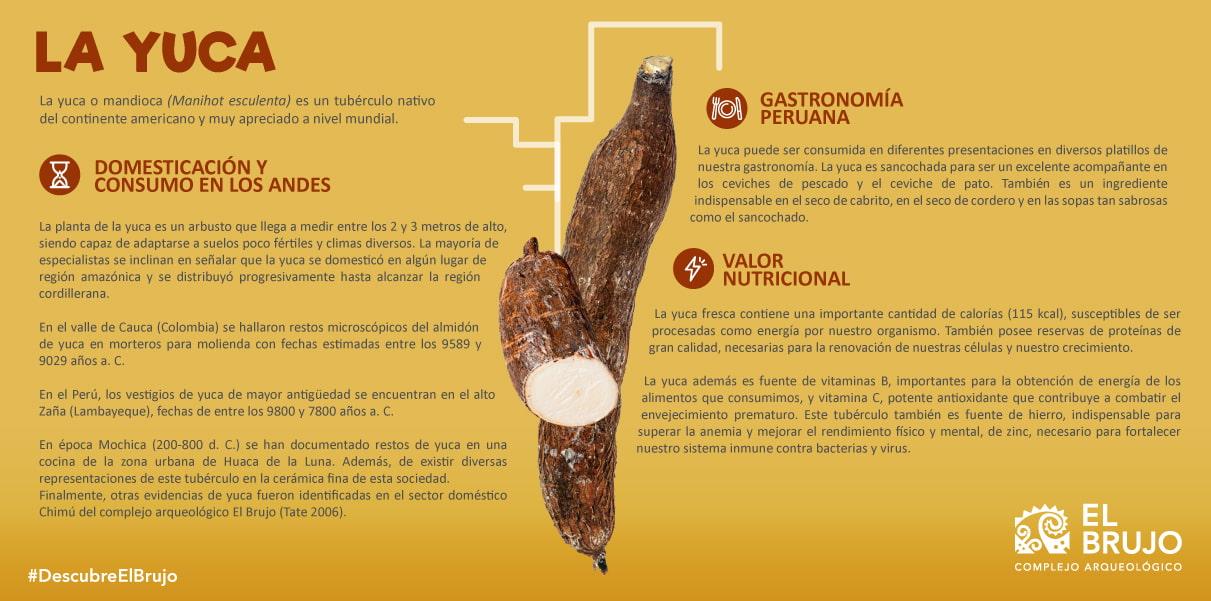
Yuca in Peruvian gastronomy
Yuca can be consumed in different presentations in various dishes of our gastronomy. Yuca is parboiled to make it an excellent companion to fish ceviche and duck ceviche. It is also an indispensable ingredient in dry baby goat, dry lamb and soups as tasty as parboil.
The exquisite chicken and fish chicharrones (deep-fried chunks) also include fried yucas. Also, they are popularly consumed with various sauces.
On the other hand, this tuber is an ingredient for delicious desserts such as chapana, an ancient sweet made with yuca, chancaca (panela) and wrapped with corn husks. Another sweet where yuca is included is in the popular picarones (deep-fried squash and sweet potato doughnuts) bathed with honey.
Finally, yuca is a key ingredient in masato, a traditional drink of the Amazonian peoples where this tuber is fermented and then consumed collectively.
Nutritional value of the yuca
Fresh yuca contains a significant amount of calories (115 kcal), capable of being processed as energy by our body. It also has reserves of high-quality proteins, necessary for the renewal of our cells and our growth.
Yuca is also a source of B vitamins, important for obtaining energy from the food we consume, and vitamin C, a powerful antioxidant that helps fight premature aging. This tuber is also a source of iron, essential to overcome anemia and improve physical and mental performance, and zinc, necessary to strengthen our immune system against bacteria and viruses.
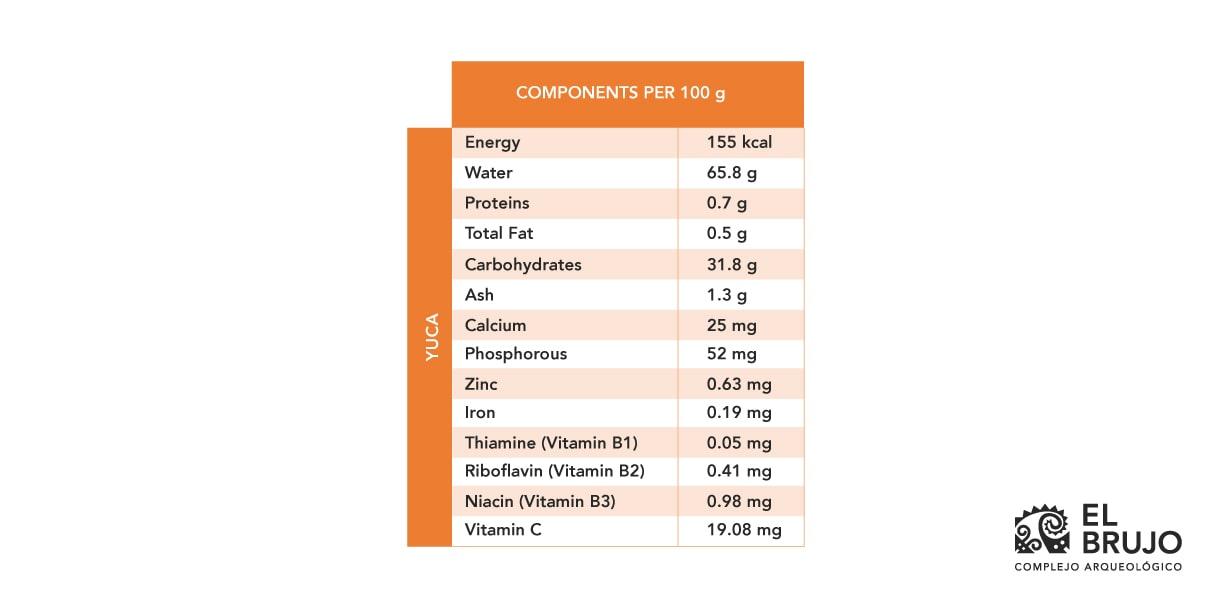
Table of nutritional value of yuca without skin Based on information published by the National Institute of Health (Reyes, Gómez-Sánchez, and Espinoza 2017:68-69).
You can also read:
1. Andean Food Series: The andean potato
2. Andean Food Series: The sweet potato
3. Agriculture: Learn about the food plants consumed by the Mochica
Bibliographic references
-
- Canales, Nella, and Mónica Trujillo. 2021. The yuca value network and its potential in the bioeconomy of Colombia. Stockholm: Stockholm Environment Institute.
- Dillehay, Tom D., ed. 2011. From Foraging to Farming in the Andes: New Perspectives on Food Production and Social Organization. Cambridge University Press.
- Fernández, Alejandro, and Eric Rodríguez. 2007. Ethnobotany of Pre-Hispanic Peru. Herbarium Truxillense. Trujillo: Universidad Nacional de Trujillo.
- Leon, Elmo. 2013. 14,000 years of food in Peru. Lima: Universidad de San Martín de Porres.
- Reyes, María, Iván Gómez-Sánchez and Cecilia Espinoza. 2017. Peruvian tables of food composition. Lima: Ministry of Health, National Institute of Health.
- Tate, James Patrick. 2006. «The Late Horizon occupation of the El Brujo site complex, Chicama Valley, Peru». PhD Dissertation, University of California at Santa Barbara.
- Vásquez, Victor, and Teresa Rosales. 2006. "Analysis of Organic Remains (Zoological and Botanical) of CA-35 and CA-17, Moche Urban Zone - Huaca de la Luna". Pp. 275-302 in Huaca de la Luna Archaeological Project. Informe Técnico 2005, edited by S. Uceda and R. Morales. Trujillo: National University of Trujillo.
Students , outstanding news


